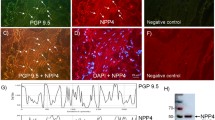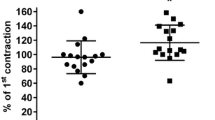Abstract
Flocalin (FLO) is a new ATP-sensitive K+ (KATP) channel opener (KCO) derived from pinacidil (PIN) by adding fluorine group to the drug’s structure. FLO acts as a potent cardioprotector against ischemia-reperfusion damage in isolated heart and whole animal models primarily via activating cardiac-specific Kir6.2/SUR2A KATP channels. Given that FLO also confers relaxation on several types of smooth muscles and can partially inhibit l-type Ca2+ channels, in this study, we asked what is the mechanism of FLO action in bladder detrusor smooth muscle (DSM). The actions of FLO and PIN on contractility of rat and guinea pig DSM strips and membrane currents of isolated DSM cells were compared by tensiometry and patch clamp. Kir6 and SUR subunit expression in rat DSM was assayed by reverse transcription PCR (RT-PCR). In contrast to PIN (10 μM), FLO (10 μM) did not produce glibenclamide-sensitive DSM strips’ relaxation and inhibition of spontaneous and electrically evoked contractions. However, FLO, but not PIN, inhibited contractions evoked by high K+ depolarization. FLO (40 μM) did not change the level of isolated DSM cell’s background K+ current, but suppressed by 20 % l-type Ca2+ current. Determining various Kir6 and SUR messenger RNA (mRNA) expressions in rat DSM by RT-PCR indicated that dominant KATP channel in rat DSM is of vascular type involving association of Kir6.1 and SUR2B subunits. Myorelaxant effects of FLO in bladder DSM are explained by partial blockade of l-type Ca2+ channel-mediated Ca2+ influx rather than by hyperpolarization associated with increased K+ permeability. Thus, insertion of fluorine group in PIN’s structure made the drug more discriminative between Kir6.2/SUR2A cardiac- and Kir6.1/SUR2B vascular-type KATP channels and rendered it partial l-type Ca2+ channel-blocking potency.






Similar content being viewed by others
References
Andersson KE, Andersson PO, Fovaeus M, Hedlund H, Malmgren A, Sjögren C (1988) Effects of pinacidil on bladder muscle. Drugs 36(Suppl 7):41–9
Burnstock G (2009) Purinergic cotransmission. Exp Physiol 94(1):20–4
Bychkov R, Gollasch M, Ried C, Luft FC, Haller H (1997) Effects of pinacidil on K+ channels in human coronary artery vascular smooth muscle cells. Am J Physiol 273(1 Pt 1):C161–71
Casteels R, Kitamura K, Kuriyama H, Suzuki H (1977) Excitation-contraction coupling in the smooth muscle cells of the rabbit main pulmonary artery. J Physiol 271(1):63–79
Gopalakrishnan M, Whiteaker KL, Molinari EJ, Davis-Taber R, Scott VE, Shieh CC, Buckner SA, Milicic I, Cain JC, Postl S, Sullivan JP, Brioni JD (1999) Characterization of the ATP-sensitive potassium channels (KATP) expressed in guinea pig bladder smooth muscle cells. J Pharmacol Exp Ther 289(1):551–8
Kanai A, Andersson KE (2010) Bladder afferent signaling: recent findings. J Urol 183(4):1288–95
Khan RN, Morrison JJ, Smith SK, Ashford ML (1998) Activation of large-conductance potassium channels in pregnant human myometrium by pinacidil. Am J Obstet Gynecol 178(5):1027–34
Lymarenko IV (2005) The comparative study of the effect of new fluorine-containing guanidine-derivate compounds and pinacidil on contractile function of the urinary bladder in vitro. Fiziol Zh 51(3):88–91, Ukrainian
Mokhort NA, Samarskaia IV, Iagupol’skaia LM (2007) Comparative study of the effects of new fluorine-containing pinacidyl analogs on bladder contractile function and vessel tone. Eksp Klin Farmakol 70(4):32–4, Russian
Nichols CG (2006) KATP channels as molecular sensors of cellular metabolism. Nature 440(7083):470–6
Petkov GV (2011) Role of potassium ion channels in detrusor smooth muscle function and dysfunction. Nat Rev Urol 9(1):30–40
Reimann F, Gribble FM, Ashcroft FM (2000) Differential response of K(ATP) channels containing SUR2A or SUR2B subunits to nucleotides and pinacidil. Mol Pharmacol 58(6):1318–25
Shindo T, Yamada M, Isomoto S, Horio Y, Kurachi Y (1998) SUR2 subtype (A and B)-dependent differential activation of the cloned ATP-sensitive K+ channels by pinacidil and nicorandil. Br J Pharmacol 124(5):985–91
Strutyns’kyĭ RB (2010) The vasodilation effects of flokalin, a fluorine-containing K(ATP) channel opener. Fiziol Zh 56(4):59–65, Ukrainian
Strutyns’kyĭ RB, Neshcheret OP, Tumanovs’ka LV, Rovenets’ RA, Moĭbenko OO (2009) Cardioprotective effects of flokalin in experiments in vivo: influence on hemodynamic and myocardial lesions in ischemia-reperfusion. Fiziol Zh 55(5):9–16, Ukrainian
Strutyns’kyĭ RB, Rovenets’ RA, Strutyns’ka NA, Neshcheret OP, Moĭbenko OO (2013) The influence of activation of the ATP-sensitive potassium channels by flocalin on the function of the cardiovascular system. Fiziol Zh 59(1):11–6, Ukrainian
Vladimirova IA, Lankin YN, Philyppov IB, Sushiy LF, Shuba YM (2014) Frequency dependence of excitation–contraction of multicellular smooth muscle preparations: the relevance to bipolar electrosurgery. J Surg Res 186(1):119–25
Voitychuk OI, Strutynskyi RB, Yagupolskii LM, Tinker A, Moibenko OO, Shuba YM (2011) Sarcolemmal cardiac K(ATP) channels as a target for the cardioprotective effects of the fluorine-containing pinacidil analogue, flocalin. Br J Pharmacol 162(3):701–11
Voitychuk OI, Strutynskyi RB, Moibenko OO, Shuba YM (2012) Effects of fluorine-containing opener of ATP-sensitive potassium channels, pinacidil-derivative flocalin, on cardiac voltage-gated sodium and calcium channels. Naunyn Schmiedeberg’s Arch Pharmacol 385(11):1095–102
Yanchiy RI, Dzhuran BV, Filippov IB, Vladimirova IA (2005) Inhibitory action of ATP-dependent potassium channel activator, flocalin, on electrical and contractile activity of the smooth muscle of guinea-pig ureter. Neurophysiology (Kiev) 37(5/6):403–9
Yokoshiki H, Sunagawa M, Seki T, Sperelakis N (1998) ATP-sensitive K+ channels in pancreatic, cardiac, and vascular smooth muscle cells. Am J Physiol 274(1 Pt 1):C25–37
Acknowledgments
This study was supported by the National Academy of Sciences of Ukraine.
Author information
Authors and Affiliations
Corresponding author
Ethics declarations
All animal protocols were complied with EU Directive 2010/63/EU for animal experiments.
Conflict of interest
The authors declare that they have no conflict of interest.
Rights and permissions
About this article
Cite this article
Philyppov, I.B., Golub, A.А., Boldyriev, O.I. et al. Myorelaxant action of fluorine-containing pinacidil analog, flocalin, in bladder smooth muscle is mediated by inhibition of l-type calcium channels rather than activation of KATP channels. Naunyn-Schmiedeberg's Arch Pharmacol 389, 585–592 (2016). https://doi.org/10.1007/s00210-016-1228-4
Received:
Accepted:
Published:
Issue Date:
DOI: https://doi.org/10.1007/s00210-016-1228-4




